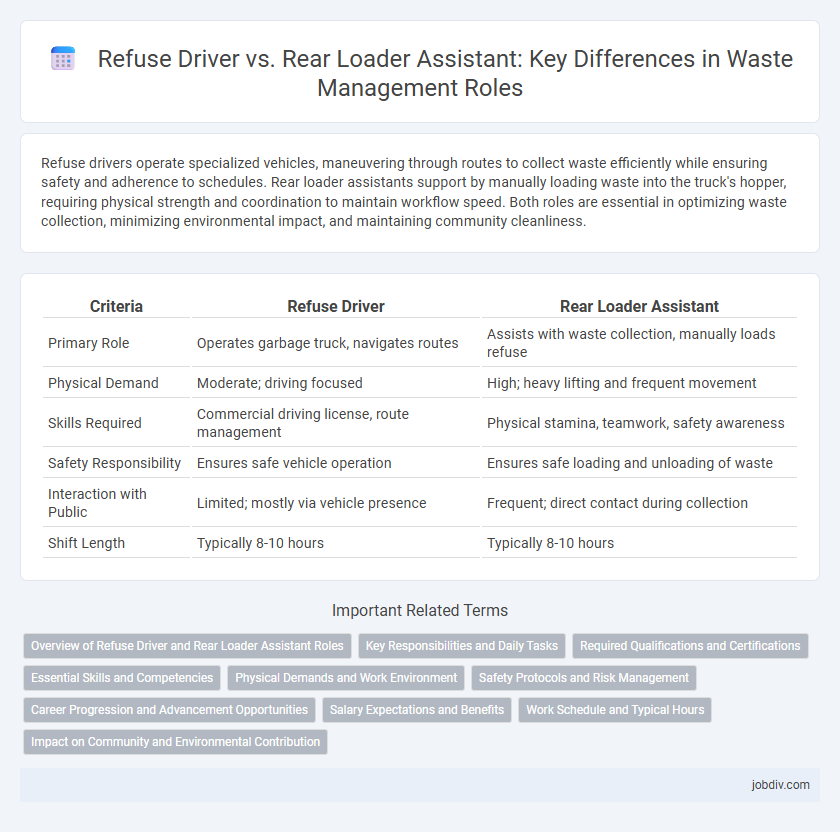Refuse drivers operate specialized vehicles, maneuvering through routes to collect waste efficiently while ensuring safety and adherence to schedules. Rear loader assistants support by manually loading waste into the truck's hopper, requiring physical strength and coordination to maintain workflow speed. Both roles are essential in optimizing waste collection, minimizing environmental impact, and maintaining community cleanliness.
Table of Comparison
| Criteria | Refuse Driver | Rear Loader Assistant |
|---|---|---|
| Primary Role | Operates garbage truck, navigates routes | Assists with waste collection, manually loads refuse |
| Physical Demand | Moderate; driving focused | High; heavy lifting and frequent movement |
| Skills Required | Commercial driving license, route management | Physical stamina, teamwork, safety awareness |
| Safety Responsibility | Ensures safe vehicle operation | Ensures safe loading and unloading of waste |
| Interaction with Public | Limited; mostly via vehicle presence | Frequent; direct contact during collection |
| Shift Length | Typically 8-10 hours | Typically 8-10 hours |
Overview of Refuse Driver and Rear Loader Assistant Roles
Refuse Drivers operate heavy waste collection vehicles, responsible for navigating routes, ensuring timely pickups, and maintaining vehicle safety and efficiency. Rear Loader Assistants support drivers by manually loading waste into the rear compactor, optimizing collection speed and maintaining safety protocols. Both roles are critical for effective waste management and require teamwork, physical stamina, and adherence to environmental regulations.
Key Responsibilities and Daily Tasks
Refuse Drivers operate garbage trucks, ensuring safe and efficient transportation of waste while navigating routes and complying with traffic laws. Rear Loader Assistants support drivers by manually collecting and loading refuse into the rear of the truck, often requiring physical strength and attention to safety protocols. Both roles require coordination to maintain timely waste collection and contribute to community sanitation.
Required Qualifications and Certifications
Refuse Drivers typically require a valid commercial driver's license (CDL) with specific endorsements for operating large waste collection vehicles, alongside training in vehicle safety and hazardous materials handling. Rear Loader Assistants often need a solid understanding of safety protocols and physical fitness, with certifications in workplace safety such as OSHA training preferred but not always mandatory. Both roles emphasize knowledge of waste management regulations, but the driver's qualifications focus more on vehicle operation and compliance, while the assistant's skills center on efficient waste handling and safety on-site.
Essential Skills and Competencies
Refuse drivers must possess strong vehicle operation skills, knowledge of routing systems, and adherence to safety protocols to efficiently manage waste collection schedules. Rear loader assistants require physical stamina, teamwork abilities, and quick reflexes to handle waste loading, sorting, and compacting tasks effectively. Both roles demand reliability, communication skills, and a commitment to environmental regulations to ensure successful waste management operations.
Physical Demands and Work Environment
Refuse Drivers endure high physical demands, often managing heavy vehicle controls and navigating challenging urban routes, requiring endurance and strength. Rear Loader Assistants engage in intense manual labor, frequently lifting and maneuvering heavy waste containers in varied weather conditions, emphasizing agility and stamina. Both roles operate in noisy, outdoor environments with exposure to potential hazards like moving machinery and traffic.
Safety Protocols and Risk Management
Refuse drivers and rear loader assistants adhere to strict safety protocols to minimize workplace hazards and ensure efficient waste collection. Drivers maintain vehicle control and monitor traffic patterns, while assistants focus on proper lifting techniques and quick, safe loading to prevent injuries. Risk management strategies include regular equipment inspections, use of personal protective equipment (PPE), and adherence to established traffic and waste handling regulations.
Career Progression and Advancement Opportunities
Refuse drivers benefit from higher responsibility and technical skill requirements, positioning them for supervisory or fleet management roles within waste management companies. Rear loader assistants gain foundational experience and can advance to driver positions or specialize in equipment operation, offering a clear pathway for career growth. Both roles provide essential industry knowledge, but drivers generally access faster progression to leadership and higher earning potential.
Salary Expectations and Benefits
Refuse drivers typically earn higher salaries than rear loader assistants, with average annual wages ranging between $40,000 and $55,000 depending on experience and location. Rear loader assistants often receive hourly wages around $12 to $18, supplemented by benefits such as health insurance, retirement plans, and paid time off. Both roles may qualify for overtime pay, but refuse drivers tend to have greater access to bonuses and advancement opportunities within waste management companies.
Work Schedule and Typical Hours
Refuse drivers typically work early morning shifts, often starting between 4 AM and 6 AM, with schedules extending 8 to 12 hours depending on route length and workload. Rear loader assistants usually have similar start times but may experience more variable hours due to manual collection tasks and assistance duties, often totaling 8-hour shifts. Both roles may require weekend or holiday work, with overtime common during peak waste collection periods.
Impact on Community and Environmental Contribution
Refuse drivers ensure efficient waste collection by maneuvering heavy vehicles through neighborhoods, directly reducing litter and improving public health. Rear loader assistants support waste compaction and loading, enhancing operational speed and minimizing environmental footprint by optimizing landfill space. Both roles contribute to cleaner communities and sustainable waste management through effective collaboration.
Refuse Driver vs Rear Loader Assistant Infographic

 jobdiv.com
jobdiv.com